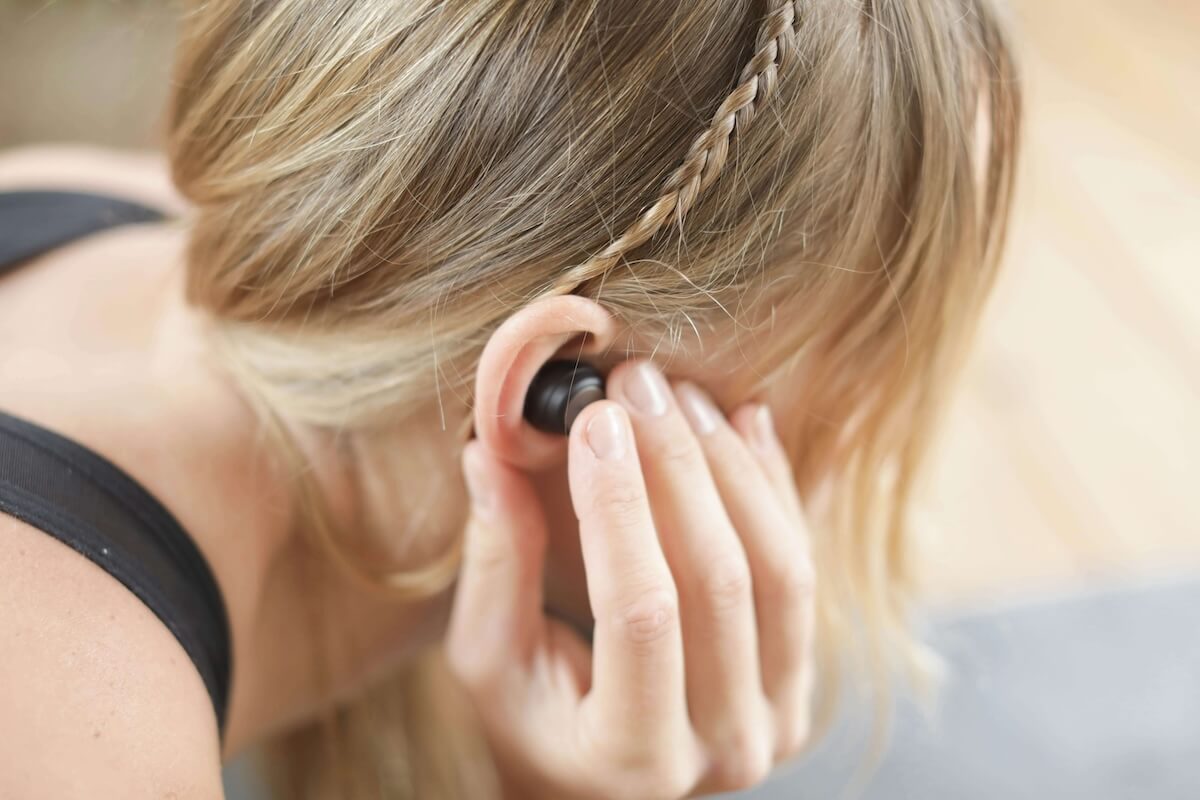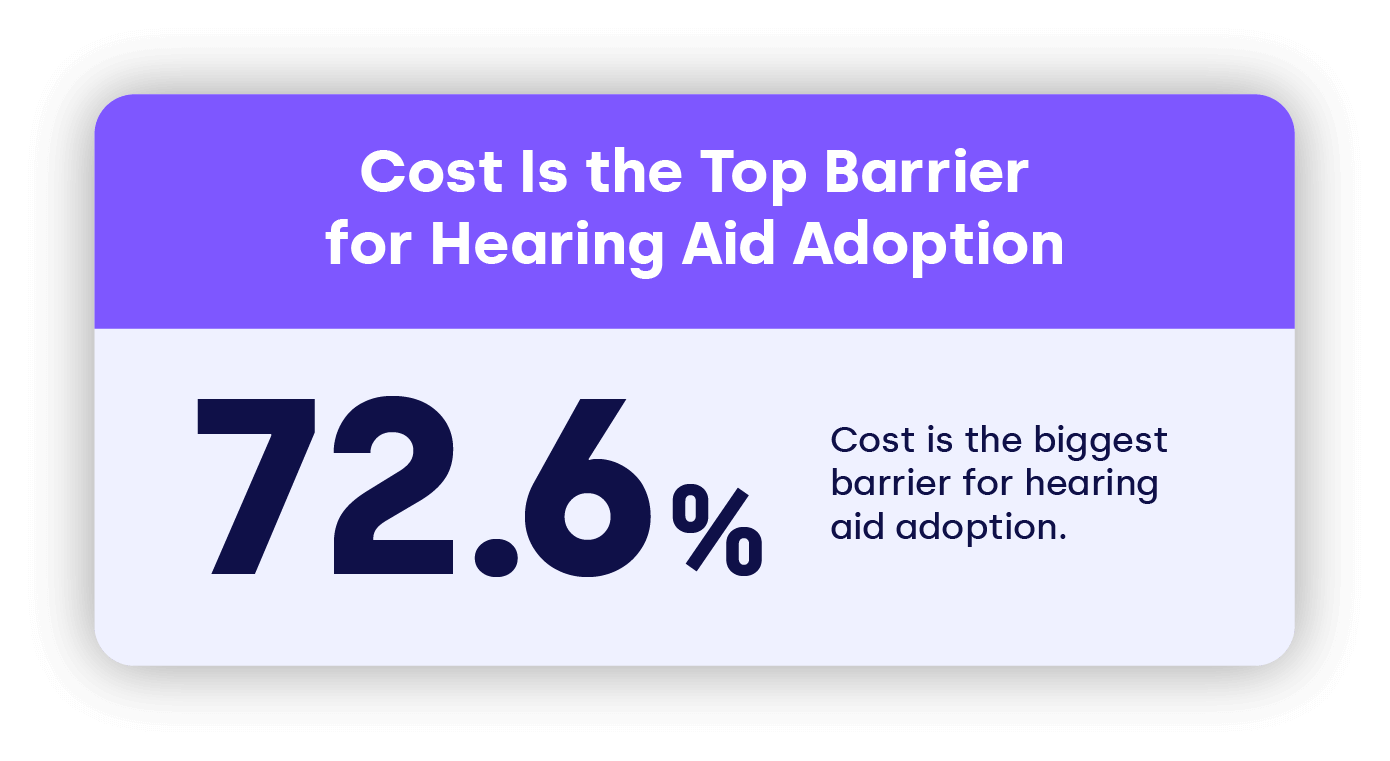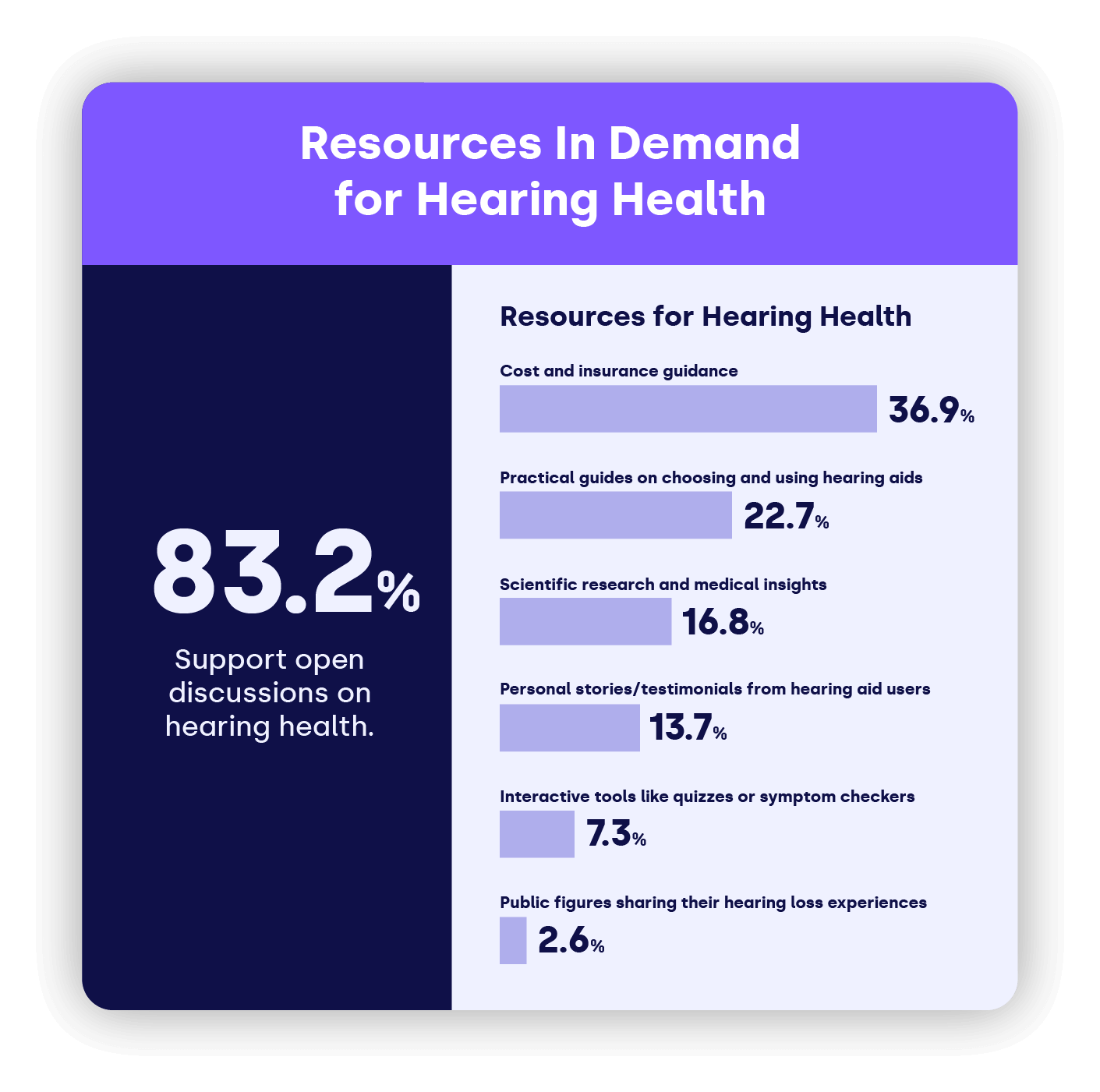Report: Hearing Health Awareness Needed Across Generations
Targeted resources and accessible information can help each demographic take a proactive role in hearing health.
 woman wearing a hearing aid
woman wearing a hearing aid
According to the National Institute of Health, roughly 28.8 million U.S. adults could benefit from hearing aids. But here’s the fascinating part: For adults aged 70 or older, only 30% have tried them. For adults aged 20-69, that number drops to 16%.
Our team surveyed 1000 respondents to investigate the reasons for the disparity between the prevalence of hearing-related problems and hearing aid usage. We examined health perceptions, obstacles to hearing aid adoption, generational attitudes, and sources of health information. The result provided essential insights into hearing loss, related perceptions, and strategies to enhance awareness and promote conversations about hearing health.
Key Takeaways
- There is a need for more discussion about hearing health — 83% of respondents believe it should be openly discussed.
- The biggest barrier is the cost of hearing aids — About 73% of respondents indicate that high prices are one of the main reasons for not adopting hearing aid use.
- Hearing loss diagnosis is underreported — Among people self-reporting hearing loss, only 14% are diagnosed.
- Younger generations go digital for health information — About 27% of younger generations get health information online, which suggests an opportunity for awareness campaigns.
There’s a Significant Gap in Hearing Loss Awareness
Our survey confirmed a noticeable gap between individuals who could benefit from hearing aids versus those who use them. Although approximately 32% of respondents reported experiencing hearing loss or hearing impairment, only 14.4% had been professionally diagnosed. Furthermore, only 11.8% of the respondents who reported hearing loss use hearing aids daily or occasionally. These findings indicate that not only is there a gap in seeking or receiving care related to hearing health, but there is also a definite gap in the adoption of hearing aids, even when needed.
This lapse in hearing health diagnosis or treatment could be related to a general lack of awareness or assumptions. For example, some may assume hearing loss that requires medical intervention typically happens within older demographics. Others may feel their hearing loss isn’t significant enough to warrant being seen. Or, if the hearing loss is possibly due to exposure to loud noise or something temporary, such as infections or deficiencies, they may assume it will go away.
“The most common reasons for a patient’s first visit with [an audiologist] is either tinnitus, physician referral for hearing loss, or family encouraging someone to get evaluated due to excessive ‘what’s and turning up the TV,” says Jessica Hinson, Au.D, one of our board members. She explains that patients typically report difficulty hearing what their family is saying or being unable to distinguish similar words
However, many may not know that hearing damage can occur without significant symptoms. Using earbuds to listen to music while working or exercising can also cause hearing loss if the volume exceeds a safe range of decibels. As earbuds have become a more popular and convenient way of listening to music in the last few decades, many individuals may have undiagnosed hearing loss. Also, signs of hearing loss may not be undeniably present.
Signs of mild hearing loss:
- Having a hard time hearing softer sounds, such as whispers or a refrigerator humming
- Having difficulty understanding speech in noisy environments
- Not being able to hear the person on the other end of a phone call
- Needing to turn up the volume when watching TV or listening to music
- Frequently having to ask people to repeat themselves during conversations
- Speech sounding muffled
- Frequently missing phone calls or failing to hear the doorbell ring
Awareness of these indicators of mild hearing loss could help motivate individuals to seek more information or care from an audiologist, bridging the gaps found by the survey between hearing loss and diagnosis and between diagnosis and treatment with hearing aids.
Cost is the Top Barrier to Hearing Aid Adoption
Concerns about the stigma associated with needing hearing aids or denial of needing them were among respondents’ reasons for avoiding them. Still, the expense of getting them appeared to be the number-one barrier. For approximately 73% of respondents, cost was the number-one reason for not adopting hearing aids. This may highlight a need for financial assistance with hearing aids or more programs to help make hearing aids more affordable. It also may point to a need for more awareness of affordable hearing aid options where readily available online resources can be helpful.
Hinson says addressing a cost and stigma issue is pretty easy, as most states mandate money-back trial periods for hearing aids.
“Seeing (or hearing) is believing as they say,” says Hinson.
Our survey also found that about 58% of respondents said the affordability of hearing aids would be one of their strongest motivators for adopting them. Many assume prescription hearing aids are the only option when, in reality, the best OTC hearing aids are often more affordable.
The biggest motivation for getting hearing aids was worsening hearing difficulties, according to 52% of respondents. Furthermore, with many over-the-counter and prescription options, finding the best affordable hearing aids has gotten easier. In some cases, insurance may even cover the cost of hearing aids for eligible individuals, which may help more individuals move past the cost barrier.
However, even at an affordable price, it’s worth noting that 41% of respondents reported their doctor’s recommendation holds more influence over their decision on hearing aids than social encouragement (15.4%) or media representation (6.4%). This could point to a challenge for online awareness campaigns or ads. Compared to a doctor’s advice, they may not hold as much clout as needed to impact hearing aid buy-in.
Comfort is Another Common Barrier
Second only to the cost of hearing aids, the next most common barrier to hearing aid adoption was comfort. Even though hearing aids have come a long way since their inception regarding size, style, fit, and capabilities, the perceived discomfort of wearing a device may be off-putting for many individuals. However, technological advancements have made hearing aids more discreet and functional. In addition, more information about the prevalence of hearing loss is helping to reduce this stigma.
Jessica Hinson, Au.D., said that while she personally only sees a 3% return rate on hearing aids, most patients are still surprised about how comfortable, discreet, and lightweight the hearing aids are now compared to devices their parents and grandparents used or the ones they see in online ads/media.
“Many sites and blogs referencing hearing aids are still using old outdated images, showing devices with large bodies, large domes, and often in unappealing colors such as the one we’ve affectionately nicknamed ‘bandaid beige,” says Hinson.
Along with being pleasantly surprised by the comfort, style, and options in today’s hearing aids, Hinson says patients often note that they did not realize how much they were missing out on by going without hearing aids.
“Patients frequently report feeling like they have cotton in their ears when they take their hearing aids out,” Hinson says. “[After using hearing aids], they get so used to hearing crisp and clear sound that their usual, unaided hearing sounds dull to them.”
Perception Isn’t a Barrier
Despite about 26% of respondents reporting some stigma surrounding wearing hearing aids, most said they had a neutral stance. Exactly 45% said they perceived hearing aid use neutrally, meaning their public opinion on wearing them is neither strongly positive nor overtly negative. Only 14.5% reported a negative view of wearing hearing aids, which presents an opportunity for awareness campaigns to push more favorable perceptions and remove barriers.
Campaigns with these end goals could focus on educating relevant demographics on the positive or versatile aspects of hearing aids while targeting barriers. For example, some campaigns could place ads for affordable hearing aid options on the websites these demographics use most, or spread information about insurance or funding options for acquiring hearing aids. Other campaigns could raise awareness about the various styles and comfortable fits of hearing aids. These campaigns could model hearing aids on young/active demographics to help remove any stigma and demonstrate how compatible certain hearing aid options are with an active lifestyle.
Hearing Education is Needed
Along with educating all demographics on hearing aid affordability and comfort, promoting information about hearing health should be another priority. Overall, survey respondents agreed that hearing health should be discussed more. About 83% of survey respondents believe hearing health should be discussed openly with their healthcare provider and peers, such as vision or dental health.
Making hearing health a topic of conversation on a more regular basis helps more individuals proactively care for their hearing health before there are issues, and it also allows for normalizing hearing challenges and treatment for such challenges.
At least one third of respondents do not seek out information about their hearing at all. Healthcare providers could help by incorporating hearing screenings into regular checkups, followed by any referral to an audiologist to diagnose and treat hearing issues.
Of those respondents who do seek information about their hearing, many are accessing that information digitally on smart devices: younger generations tend to rely more on online resources (27%) and social media (~10%), showing a digital opportunity for awareness campaigns.
Given these statistics and the gaps in hearing health education that it brings to light, there is a definite opportunity to reshape conversations about hearing loss. For example, digital awareness campaigns that place resources about hearing loss and hearing aids on the platforms individuals use most frequently can encourage more in-depth research that leads viewers to insights about their hearing health. This can, in turn, prompt a more proactive approach to hearing exams and positively affect patient outcomes and hearing aids becoming more mainstream.
Find Hearing Health Resources
Audiologists.org is a collective of healthcare leaders and entrepreneurs leveraging insights from leading audiologists to spread helpful information to the public. While nothing can replace direct consultation with an audiologist, audiologists.org makes self-education possible by providing in-depth resources and tools.
Spurring conversations about hearing loss and helping them gain momentum can help everyone play a more proactive role in assessing their hearing health. With the right tools and resources, even the best hearing aids can be affordable, readily accessible, and comfortable, improving the quality of daily life for those with unique hearing needs.
“Overall, my recommendation to prospective hearing aid users is to get annual hearing testing starting at age 55, as research shows the earlier hearing loss is addressed, the better the outcome,” Hinson says. “Seek advice from a respected audiologist who can give you both value-based and results-based recommendations, and if hearing loss is detected, complete a full hearing aid trial to see what you are truly missing otherwise.”
Methodology
Audiologists.org administered a 10-question, multiple-choice survey to 1,000 individuals (444 male respondents and 556 female respondents) across various age groups to collect information about the insights shared. Respondents ranged in age from 18 to 78, with the majority (73.4%) being in the Gen-X and Baby Boomer generations. This matters because this specific age group tends to have a higher prevalence of hearing-related issues than other age groups.
Sources:


